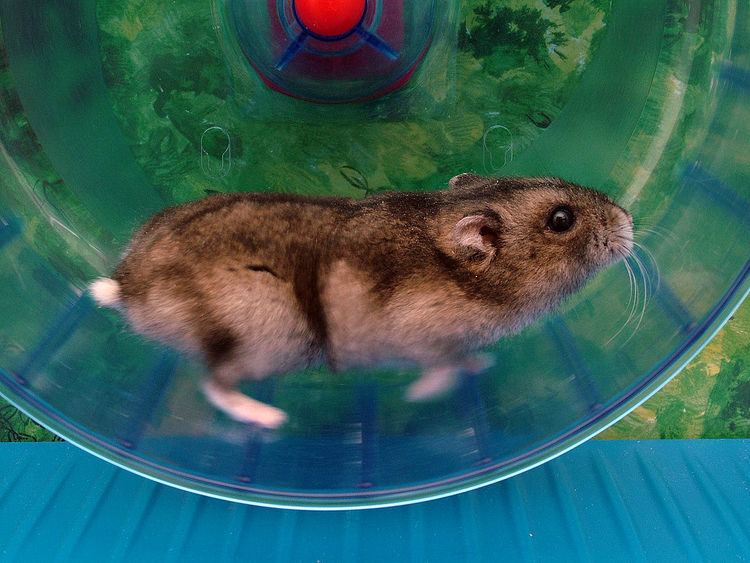 | ||
Hamster wheels or running wheel are exercise devices used primarily by hamsters and other rodents, but also by other cursorial animals when given the opportunity. Most of these devices consist of a runged or ridged wheel held on a stand by a single or pair of stub axles. Hamster wheels allow rodents to run even when their space is confined. The earliest dated use of the term "hamster wheel", located by the Oxford English Dictionary, is in a 1949 newspaper advertisement.
Contents
Use by animals
Like other rodents, hamsters are highly motivated to run in wheels; it is not uncommon to record distances of 9 km (5.6 mi) being run in one night. Other 24-h records include 43 km (27 mi) for rats, 31 km (19 mi) for wild mice, 19 km (12 mi) for lemmings, 16 km (9.9 mi) for laboratory mice, and 8 km (5.0 mi) for gerbils. Hypotheses to explain such high levels of running in wheels include a need for activity, substitute for exploration, and stereotypic behaviour. However, free wild mice will run on wheels installed in the field, which speaks against the notion of stereotypic behaviour induced by captivity conditions. Alternatively, various experimental results strongly indicate that wheel-running, like play or the endorphin or endocannabinoid release associated with the 'runner's high', is self-rewarding. Wheel use is highly valued by several species as shown in consumer demand studies which require an animal to work for a resource, i.e. bar-press or lift weighted doors. This makes running wheels a popular type of enrichment to the captivity conditions of rodents.
Captive animals continue to use wheels even when provided with other types of enrichment. In one experiment, Syrian hamsters that could use tunnels to access five different cages each containing a toy, showed no more than a 25% reduction in running-wheel use compared to hamsters housed in a single cage without toys (except for the running wheel). In another study, female Syrian hamsters housed with a nestbox, bedding, hay, paper towels, cardboard tubes, and branches used a wheel regularly, and benefitted from it as indicated by showing less stereotypic bar-gnawing and producing larger litters of young compared to females kept under the same conditions but without a wheel. Laboratory mice were prepared to perform more switch presses to enter a cage containing a running wheel compared to several metres of Habitrail tubing or a torus of Habitrail tubing.
Running in wheels can be so intense in hamsters that it may result in foot lesions, which appear as small cuts on the paw pads or toes. Such paw wounds rapidly scab over and do not prevent hamsters from continuing to run in their wheel.
Use in science
Voluntary wheel running is one of the most widely used indicators of activity and wake-time in research on circadian rhythms and other aspects of chronobiology. Miniature running wheels have even been used to measure the circadian locomotor activity of cockroaches. For rodents, running wheels are easier to set up and automate than other techniques of activity recording such as bar-gnawing and spring-suspended or knife-edge balanced cages.
In rodents, voluntary exercise is almost always measured by use of wheels. This makes running wheels the tool of choice in research on the effects of exercise and voluntary activity on metabolism, obesity, and pain.
The neurotransmitter systems involved in wheel-running behavior have received considerable study. Recent evidence suggests that changes in both dopaminergic and serotonergic tone alter running-wheel activity. For example, one study in mice has shown that several antidepressant medications (all of which directly or indirectly enhance serotonergic tone) suppress running-wheel activity without suppressing general locomotion. The endocannabinoid system also contributes to wheel running in a sex-specific manner in rodents. Mice from lines that have been selectively bred for high levels of voluntary wheel running have altered responsiveness to drugs that alter dopamine and endocannabinoid signalling, and enlarged midbrains.
Hamster ball
A related exercise device, the hamster ball, is a hollow plastic ball into which a pet can be temporarily placed. The ball allows the pet to freely roll around on the floor to explore and exercise, while preventing escape.
Running disc
A related exercise device is the running disc. This is a rotatable shallow bowl, or slightly concave disc, which is set an angle to the horizontal. Some commercial refuges for caged rodents have a disc mounted on the roof at a slight angle. The rodents run on the rim of the disc in a similar way to running in hamster wheels.
